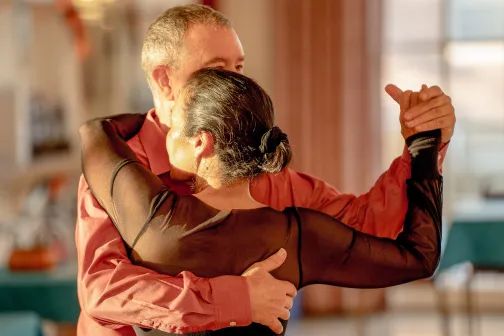When I first went to Argentina in about 1997, I saw the dancing at the salon Almagro, and was amazed by the crowded dance floor and the skill with which the leaders navigated the floor. I also realized (1) I did not learn that style and (2) I didn't really know ANYTHING about tango. I spent the next few years paying attention to how tango was danced in Argentina and trying to learn how to succeed on the dance floors in Buenos Aires.
The style of dance I observed at Club Almagro, and that I eventually succeeded with, is what I would call "Milonguero Style". But it isn't as simple as that.
Argentine Tango is interesting in that historically it was always taught "man-to-man". The modern revival is the first generation in which both men and women learn together. While earlier styles of tango existed from about the year 1900, the Golden Era and high-point of Argentine Tango was the period from about 1930 up to 1955.
In those days, tango was learned by the men in "men's practices", and the stories claim that the men danced the follower's for several or many months before they were allowed to lead, and had to become extremely competent before they could go to a tango nightclub. One useful result is that the men felt within what the followers were experiencing, as well as feeling how the leader was supposed to lead. Only experienced men were permitted in the dance salons, so women learned on the dance floor, but only from the very best.
A "milongueros" was a tango man who got really, really good by spending days and nights working on their tango. This was not necessarily a "reputable" way of life, and in fact has connotations of womanizing, drinking and living only for the nightlife. To be accurate, you cannot say there is a single "milonguero style", as each of those great dancers really had their own style.
In the great tango revival of the 1980s, some of the old milongueros came back out dancing, and we had a short window observing the social tango of the Golden era before we started losing so many of them. Do the math: if you learned tango at age 20 in 1945, you would be 70 in 1995 (still young enough, probably), and 90 in 2015.
So, What is Milonguero Style?
To generalize, the style called "milonguero" is typically very close, sometimes called "apilado" or leaning-close, emphasizes connection, and has great rhythmic drive. Perhaps the most important aspect is the primary roles of the tango music and the embrace. These then are the critical elements of milonguero style: (1) Music, (2) Rhythm, (3) Close Connection, and (4) Taking care of your partner.
It is important to credit Susana Miller for having a particular skill. She danced with the old milongueros, and figured out how to teach a younger generation their steps, choreographies, rhythms, and feel. Susana had a successful tango school for many years in the 1990s, to the point where the newspaper Clarin in Buenos Aires claimed that she probably put more people on the dance floor than any other single teacher.






